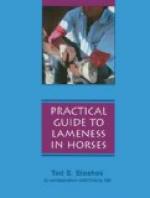Rheumatic affections, when present, usually cause recurrent attacks of lameness; myalgia, due to subsurface injury occasioned by contusion, generally produces an ephemeral disturbance; and while these are examples of cases where occult causes are active, they are by no means unprecedented. In cases where the cause of lameness is not definitely located, and when by the process of exclusion one is enabled to decide that the seat of trouble is in the hip, a tentative diagnosis of hip lameness is always appropriate.
In one instance a Shetland pony evinced a peculiar form of intermittent lameness which affected the left hip, and repeated examinations did not disclose the cause of the trouble. After about a year there was established spontaneously an opening through the integument overlying the region of the attachment of the psoas major (magnus), through which pus discharged. With the occurrence of this fistula, lameness almost entirely disappeared, but the emission of a small amount of pus persisted for more than a year. The subject was not observed thereafter and the outcome in this case is not a matter of record. Whether there existed a psoic phlegmon due to metastatic infection or necrosis of a part of a lumber or dorsal vertebra is a matter for speculation. Thus the presence of some anomalous conditions which affect the pelvic region and cause lameness may be discovered, yet both in hip and shoulder regions causes may not be definitely located by means of practical methods of examination.
Injuries of all kinds are the more frequent causes of hip lameness. In such cases, lameness may result directly and resolution be prompt, or the claudication become aggravated in time, due to muscular atrophy or degenerative changes affecting the hip joint or nerves. Rheumatism or metastatic infection may be the cause of hip lameness as well as affections of the pelvic bones, lumbar and sacral vertebrae. Hip lameness may also be provoked by melanotic or other tumors.
In the diagnosis of hip lameness, one is guided in a general way by the character of the impediment manifested. Swinging-leg lameness is often present and the impediment is more accentuated when the animal is caused to step backward. In many cases lameness is mixed, being about equally noticeable during weight bearing and while the member is being swung. By exclusion of causes which might affect other parts; one may definitely locate the cause of the trouble or determine that a certain region is affected.
The sudden manifestation of lameness is indicative of injury; thermic disturbances may signalize metastatic infection; history, if dependable, is always helpful. Repeated observations, taking into account the course which the affection assumes during a period of a few days, often serve to afford a means of establishing a diagnosis in baffling cases.
Fractures of the Pelvic Bones.
The os innominatum may be so fractured that the pelvic girdle is broken, as in fracture of the iliac shaft, or in a manner that the girdling continuity of the innominate bones is not interrupted. It naturally follows that greater injury is done when the pelvic girdle is broken than when it is not, except in cases where the acetabulum is involved and its brim not completely divided.




